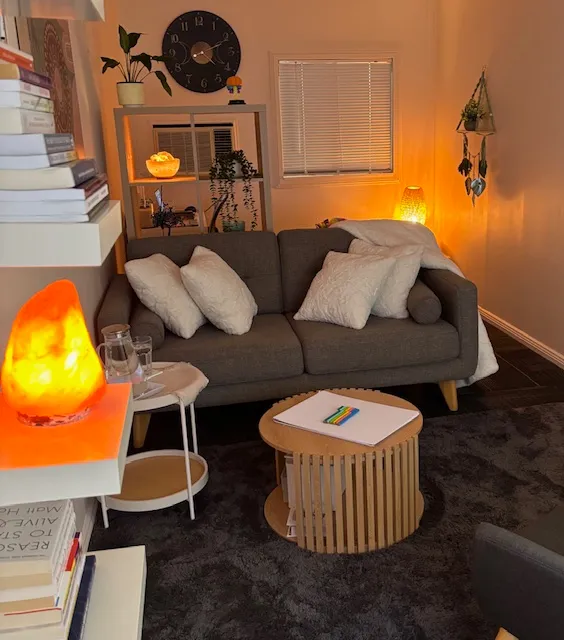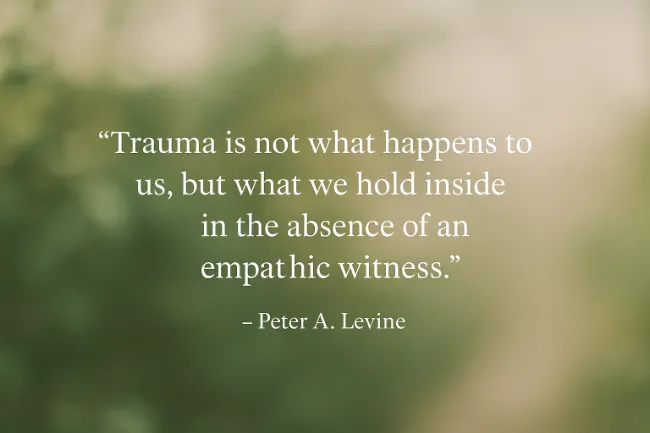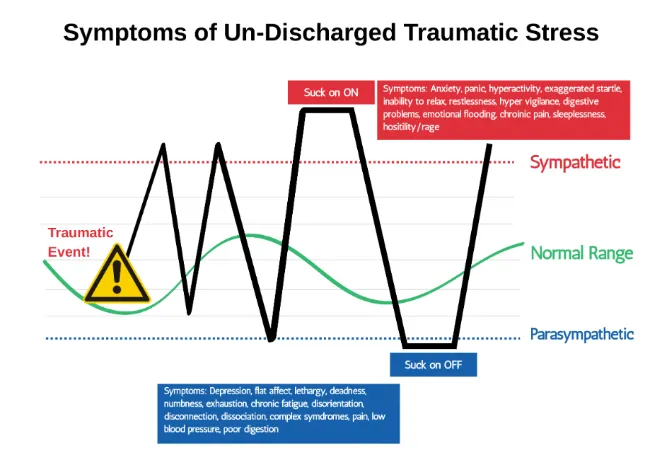Understanding Trauma
Trauma is not about the event itself, it’s about how the experience lives on in your body, mind, and nervous system. It’s the imprint left behind when something overwhelms your capacity to cope, leaving you feeling unsafe, helpless, or alone.
Any time we experience threat, whether physical, emotional, or relational, our nervous system does exactly what it’s designed to do: it moves into fight, flight, freeze, or fawn to protect us. These are healthy, human survival responses. But when the threat is too intense, goes on for too long, or we’re unable to escape or find safety, these responses can get stuck. The body stays on high alert, or shuts down completely, long after the danger has passed.
During these times of overwhelm, the brain’s hippocampus, which helps us sort and “time stamp” experiences, can’t do its job effectively. Memories of what happened may feel disorganised, looping, or ever-present, like they’re still happening now. Trauma lives on, not just as a story we remember, but as a felt experience in the body and nervous system.
How Trauma Can Show Up
Trauma doesn’t always look like what we expect. It doesn’t have to be a single event or something “big enough” to count. It can happen through shock, loss, betrayal, neglect, chronic stress, emotional wounding, or times when we felt unseen, unheard, or unsupported.
Trauma might show up as:
- Feeling anxious, shut down, or overwhelmed without knowing why
- Emotional outbursts or numbness
- A constant sense of tension, restlessness, or agitation
- Avoiding certain people, places, or emotions
- Difficulty trusting others or maintaining relationships
- Overworking, people-pleasing, or perfectionism as ways to feel safe
- Feeling like “part of me knows I’m okay, but my body doesn’t believe it”
These are not personal failings, they are the body’s best attempts at keeping you safe. As trauma experts remind us, these patterns are survival strategies that helped us endure. They often show up as symptoms, but they began as intelligent, protective responses.
Different Shapes Trauma Can Take
Trauma comes in many forms. Sometimes it’s a single event. Other times it’s the absence of safety or care over time. Sometimes it’s the pain we carry from those who came before us.
Shock Trauma
From accidents, sudden loss, medical events, assault, disasters, or any experience that was too much, too fast, or too soon for your system to process.
Relational and Developmental Trauma
The wounds that form in childhood through inconsistent caregiving, emotional neglect, abuse, or environments where safety and attunement were missing. These early experiences shape our sense of self, worthiness, and the way we connect with others.
Intergenerational Trauma
Pain and survival patterns that are passed down through families, often unspoken but deeply felt. The ways our parents or grandparents coped with their own trauma can leave imprints on our nervous systems, shaping how we move through the world.
Collective Trauma
The shared wounds carried by communities and cultures through colonisation, war, displacement, systemic oppression, racism, and injustice. Collective trauma can influence our sense of belonging, safety, and identity, even when we aren’t consciously aware of its roots.
Whether the hurt comes from something that happened directly to you, something you inherited, or the wider systems you’re part of, trauma is the body's honest response to what felt unsafe.
Trauma Responses Are Human Responses
When we understand trauma as the body’s natural way of protecting us, we can begin to meet these patterns with compassion instead of shame.
Trauma may show up as:
- Hypervigilance or feeling constantly on edge
- Difficulty calming down or feeling safe to rest
- Emotional shutdown, dissociation, or feeling spaced out
- Patterns of self-blame, shame, or feeling “broken”
- Chronic anxiety, depression, or health issues
- Feeling stuck in cycles of self-sabotage or disconnection
These responses may feel frustrating, but they were once necessary. They helped you survive.
Healing Is Possible
The nervous system has the incredible capacity to heal and re-learn safety. Healing is not about reliving the past or “getting over it.” It’s about gently creating the conditions for your system to process what’s been held and move toward balance and connection.
Through attuned relationship, body awareness, and nervous system support, healing becomes possible. The work is not about fixing you, because you are not broken. It’s about helping the parts of you that have been holding pain, fear, or shame to feel safe enough to soften.
This process is slow, compassionate, and always at your pace. If you’re curious about what this work could look like for you, I invite you to reach out.
Trauma, Neurodivergence, and the Nervous System
For many people, trauma and neurodivergence are deeply intertwined. The experience of being neurodivergent in a world that often misunderstands or invalidates difference can be traumatic in itself.
Living in environments where your natural ways of thinking, feeling, sensing, or communicating aren’t supported can lead to chronic stress on the nervous system. Experiences like being told you're “too much,” “too sensitive,” “too emotional,” or “not enough” shape how safe we feel to show up as ourselves.
Over time, these messages can lead to patterns of masking, hiding, suppressing, or overcompensating for our true selves in order to fit in or stay safe.
Masking is often a powerful and intelligent survival strategy, especially in unsafe or unaccepting environments. But it can also come at a high cost, leaving people feeling disconnected from their own needs, exhausted, and unsure of who they are underneath the mask.
Trauma adds another layer to this picture. Long-held trauma responses like hypervigilance, dissociation, shutdown, emotional flooding, or chronic overwhelm can look very similar to what gets labelled as neurodivergence. In some cases, trauma may amplify true neurodivergent traits; in others, what appears as neurodivergence may actually be the nervous system stuck in survival mode.
When we begin to work gently with trauma, helping the body and nervous system feel safe enough to process what has been held, some of the traits we thought were just “who we are” may begin to soften or shift. Focus may feel steadier. Sensory overwhelm may lessen. Emotional regulation may become easier. But this work is never about “fixing” or “normalising” you.
Neurodivergence is not something that needs to be healed or cured. What healing can do is help you discover which parts of your experience come from your beautiful neurodivergent wiring, and which parts are adaptations, protections, or trauma responses that developed to keep you safe.
The goal is not to change who you are, it’s to create enough safety in your system that you get to choose:
- When to use your survival strategies and when to rest
- Which parts of yourself feel most authentic
- How to show up in a way that feels true to you, not shaped by fear or shame
This is work that honours all parts of your story, with deep respect for both your neurodivergence and the ways your body has tried to keep you safe.
If this resonates with your experience, I welcome you to reach out and explore whether this work feels like the right fit for you.
Book Appointment






